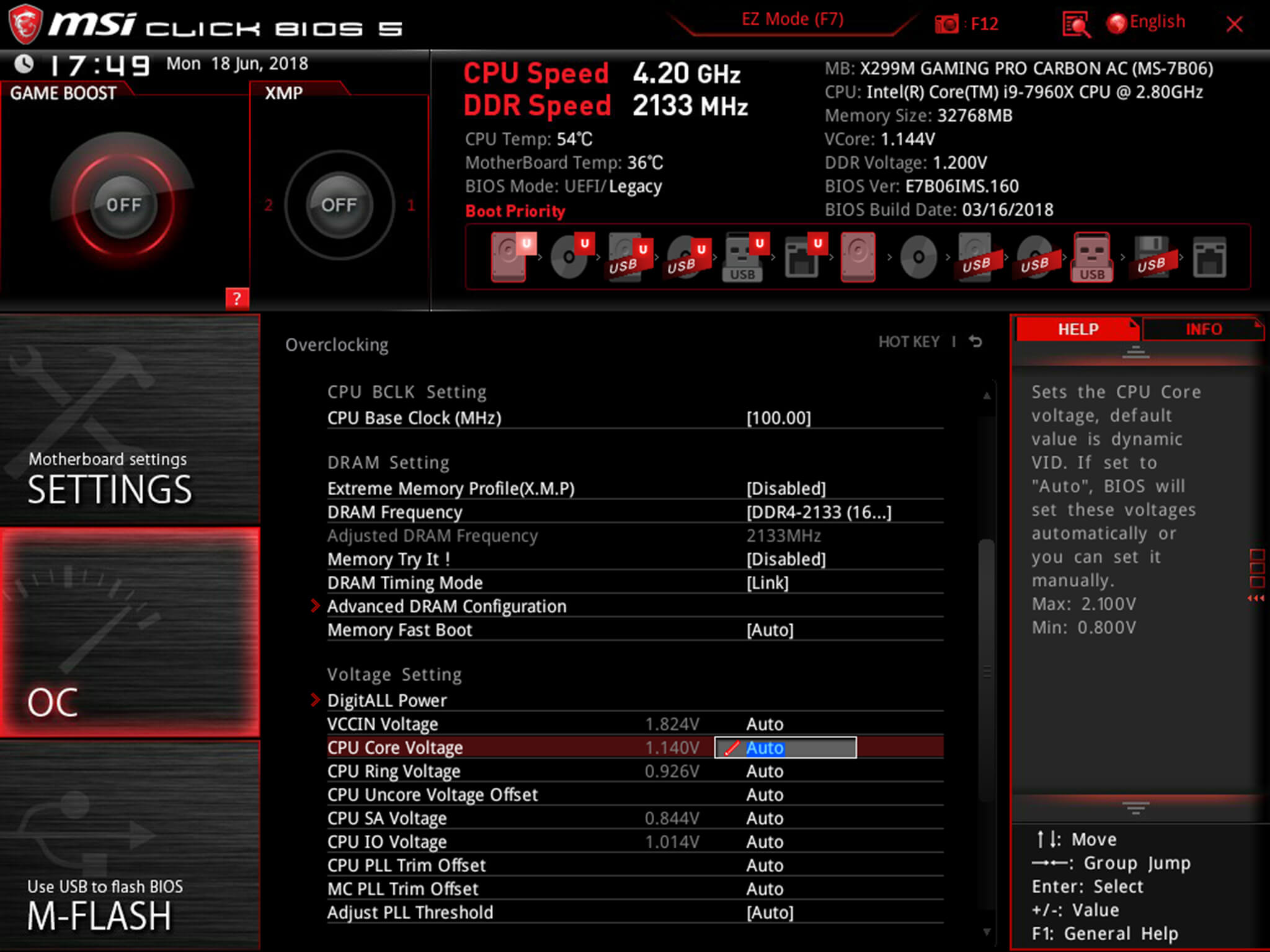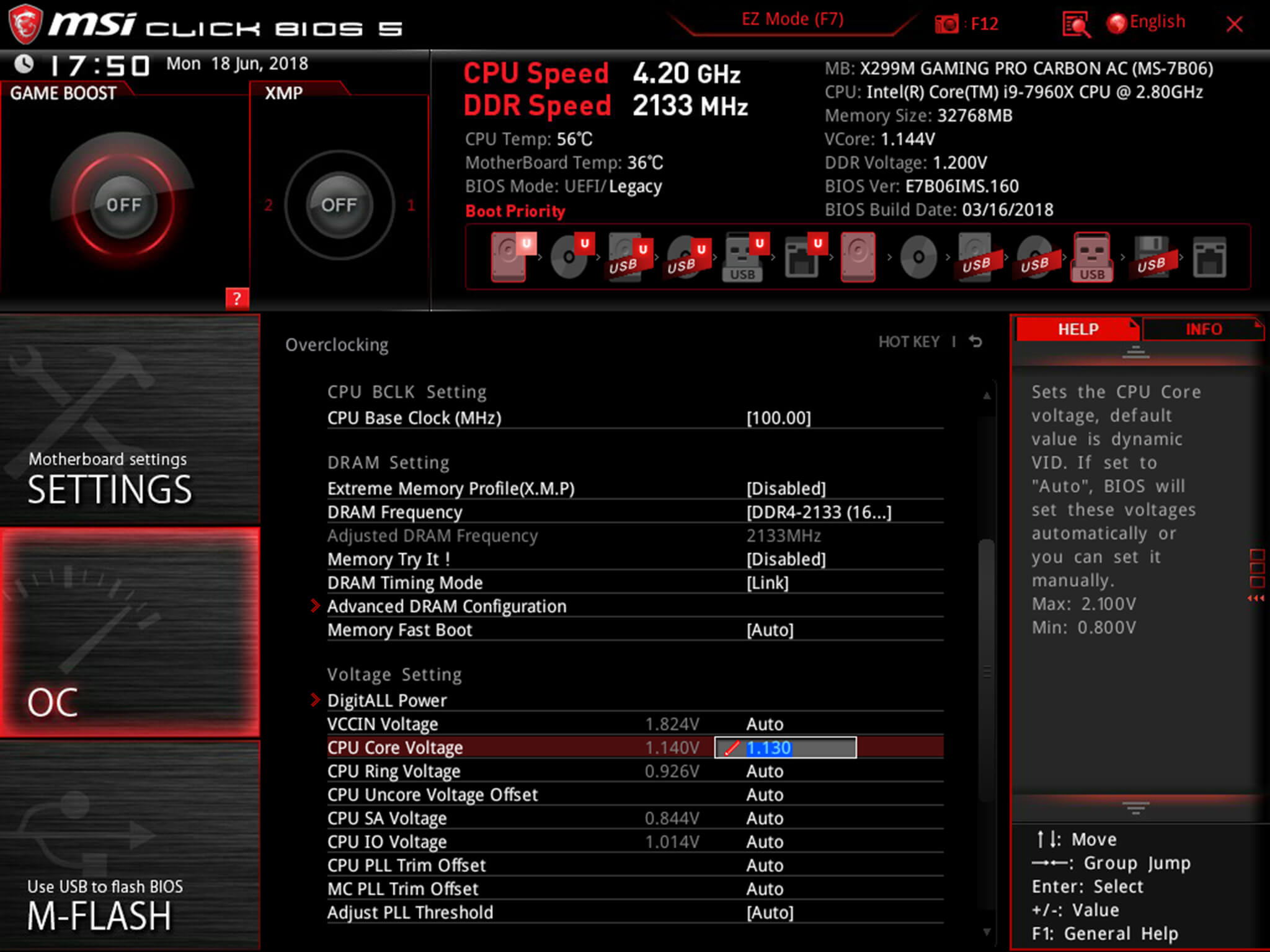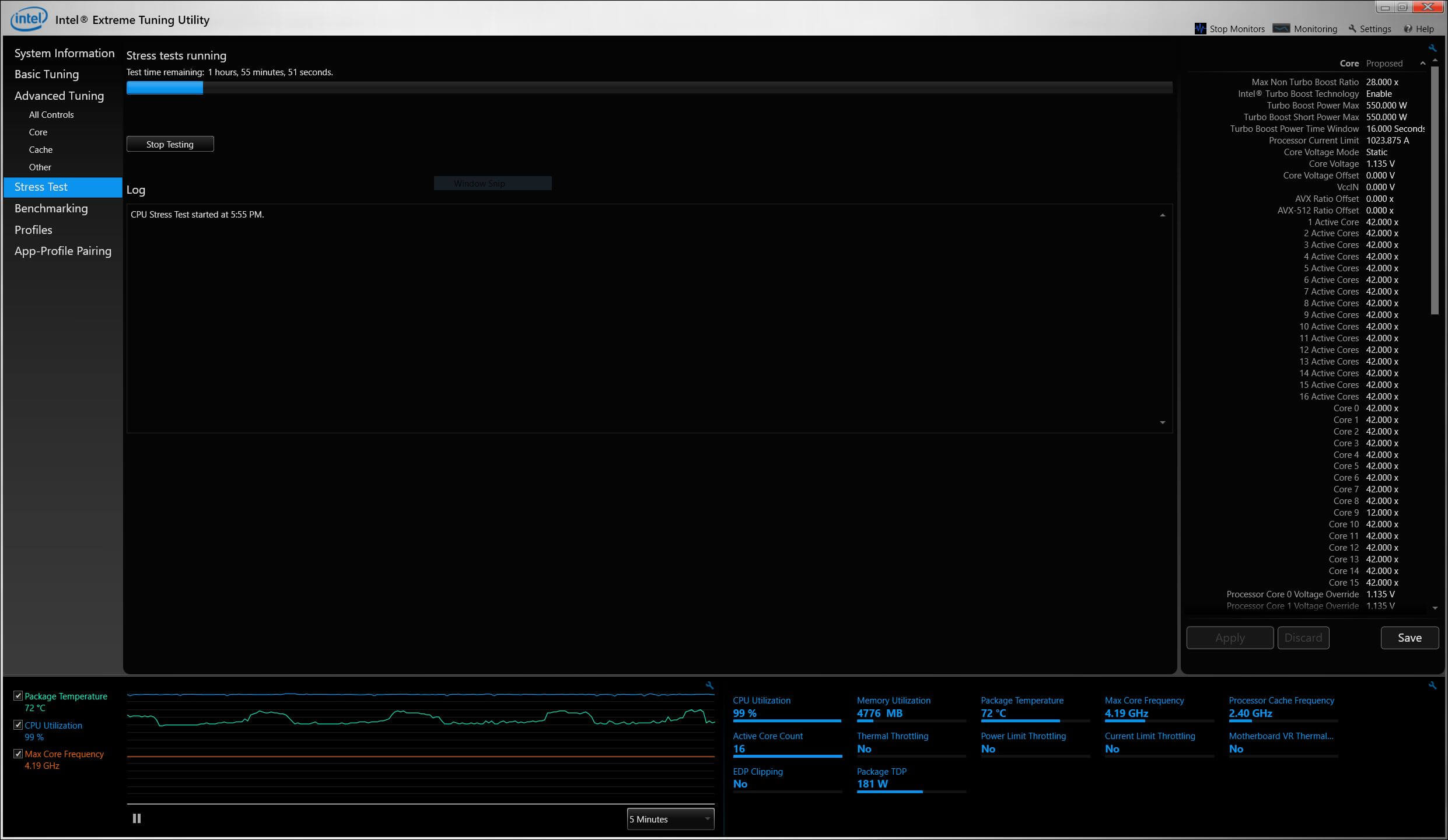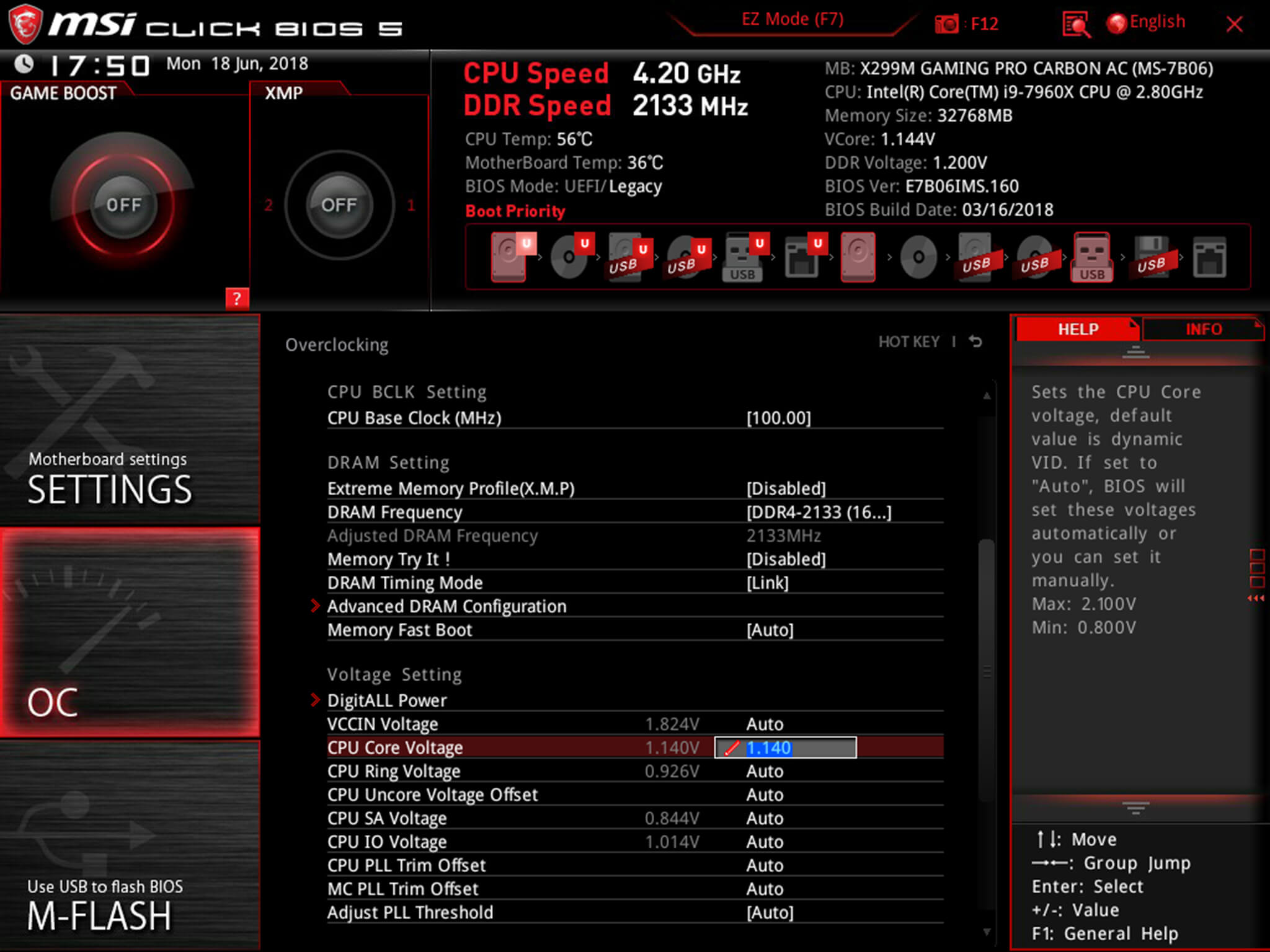The core voltage is different for each processor model, and while all CPUs of the same model have the same VID, not all samples maintain stability at the same clock speeds and Vcore due to slight variations in silicon quality. Every sample of the same CPU model is tested to maintain stability at the default speeds and the VID determined by the manufacturer.
Core voltage typically maintains a constant value while your CPU is in use; however, sometimes under heavy workloads vcore can fluctuate. This is known as Vdroop and can be corrected with load-line calibration. This applies additional voltage as load increases to maintain your CPU's stability.
When it comes to overclocking, you can only push your CPU's frequency so far before your CPU starts to experience instability. Programs might begin to crash or hang up, game performance could suffer or your computer could even fail to boot. This is because your processor isn't getting enough voltage to maintain system stability.
Increasing voltage will allow you to dial in the perfect overclock.
To adjust the voltage, you'll need to boot into your motherboard's BIOS and make adjustments there. The Vcore is expressed as a three decimal value, such as 1.235v. By default, the voltage control is set to auto; this can be overridden by typing in any value. Make sure not to exceed the recommended maximum for your processor.

Before fine-tuning the Vcore, it's important to find a good baseline value for a given speed. This varies from model to model but it can be helpful to read reviews for your CPU, specifically ones that focus on overclocking.
Most publications will list the voltage they required to keep several different speeds stable. Every CPU sample is different and you will need to fine-tune the voltage before calling it done; however, these values do provide a good starting point.

If you boot your machine and don't find any stability issues, then you know it's time to start decreasing the voltage. When overclocking, you want to find the lowest voltage required to maintain stability. More voltage equals more heat and this will allow you to keep temperatures under control.

The safest way to adjust voltage is with increments of .01 volts. Decrease voltage until your computer starts showing signs of instability under load. Use a program like Intel's Extreme Tuning Utility (XTU) or Prime95 to stress test your processor.
If the test fails or crashes, then you need to raise the voltage back up to the previous stable point. For optimal efficiency, you can increase the voltage by .005 instead and again test for stability.

Conversely, if your overclock isn't stable at your baseline voltage, you will then need to increase the voltage until your computer shows no adverse effects and then decrease in increments of .005 to fine tune.

Overclocking is not the only time it can be useful to adjust voltage. As mentioned, higher voltage levels cause your CPU to generate more heat, regardless of frequency. Some CPU samples may have a higher VID than is actually required at the default frequency. Undervolting your processor allows your to maintain stability while decreasing temperatures and extending the life of your processor.
It's a common misconception that disabling Turbo Boost is a more effective substitute for shedding heat. While this does result in decreased temperatures, it is not an alternative as the purpose of undervolting is to maintain the same level of performance while generating less heat. When making adjustments, the same principles apply here as with overclocking, decrease Vcore in increments of .01 and then fine tune with adjustments of .005.
 Shop the iPad Air and iPad 11th generation for their lowest
Shop the iPad Air and iPad 11th generation for their lowest
 Come on down! Amazon is running a contest to find where to build its new headquarters.
Come on down! Amazon is running a contest to find where to build its new headquarters.
 Now even chocolate can be millennial pink, too
Now even chocolate can be millennial pink, too
 The world's best airport has handed out smart glasses to ground staff
The world's best airport has handed out smart glasses to ground staff
 Nintendo Switch 2 release date, price announced
Nintendo Switch 2 release date, price announced
 Sheriff tweets that anyone with a warrant seeking shelter from Hurricane Irma will be jailed
Sheriff tweets that anyone with a warrant seeking shelter from Hurricane Irma will be jailed
 'Pokémon Go' will introduce trading and player vs. player battles
'Pokémon Go' will introduce trading and player vs. player battles
 Tooth fairy issues tough but fair hygiene warning after appraisal of lost tooth
Tooth fairy issues tough but fair hygiene warning after appraisal of lost tooth
 LA Galaxy vs. Tigres 2025 livestream: Watch Concacaf Champions Cup for free
LA Galaxy vs. Tigres 2025 livestream: Watch Concacaf Champions Cup for free
 Equifax execs sold off nearly $2 million in stock before massive data breach was made public
Equifax execs sold off nearly $2 million in stock before massive data breach was made public
 Eufy L60 robot vacuum: Get it for $279.95 at Amazon
Eufy L60 robot vacuum: Get it for $279.95 at Amazon
 Google Street View just got a major upgrade to look even more like the real world
Google Street View just got a major upgrade to look even more like the real world
 So, it turns out United won't be fined for that passenger
So, it turns out United won't be fined for that passenger
 Listen to the 14
Listen to the 14
 Best travel deal: Score the Frontier Go Wild! summer pass for just $399
Best travel deal: Score the Frontier Go Wild! summer pass for just $399
 Mom donates breast milk to Hurricane Harvey relief efforts
Mom donates breast milk to Hurricane Harvey relief efforts
 How one nonprofit is empowering people with disabilities in Hurricane Irma's path
How one nonprofit is empowering people with disabilities in Hurricane Irma's path
 Hurricane Hunters capture amazing footage flying into Hurricane Irma
Hurricane Hunters capture amazing footage flying into Hurricane Irma
 Amazon Spring Sale 2025: Best deals on cleaning supplies
Amazon Spring Sale 2025: Best deals on cleaning supplies
 Historic Hurricane Irma acts as buzzsaw to islands, threatens U.S.
Historic Hurricane Irma acts as buzzsaw to islands, threatens U.S.
Amazon's proposed federal antiAn iPad mini with a larger display might be coming and I'm very excitedFox News host takes Trump denial to a whole new levelSleeping woman being wheeled around campus is truly a bizarre sightHere are the best cheap headphones for working out and daily lifeEpic 'Why I left BuzzFeed' video is straight out of a Marvel movieA police officer and a baby kangaroo are a crimeAustralian fisherman plays a game of tug of war with a pesky sharkTwitter CEO Jack Dorsey accidentally livestreams meeting on PeriscopeThe internet continues to give men's rompers the meme treatmentFacebook is part of a group that will reportedly run ads to fight Silicon Valley regulationsThe designer behind Unicode's first genderTikTok faces scrutiny over minors' user data ... againTaylor Swift's alleged new boyfriend isn't even verified on Twitter yetAustralian fisherman plays a game of tug of war with a pesky shark'The Last Dance' is the greatest sports fix of the pandemicJohn Krasinski reveals he's in possession of Pam's teapot from 'The Office'Elon Musk thanks Trump for supporting Tesla factory reopeningSigns you're suffering from Trump Fatigue SyndromeTwo siblings somehow drew their mom the exact same Mother's Day card NYT Connections Sports Edition hints and answers for February 21: Tips to solve Connections #151 Rabbit just introduced a new Android AI agent. AFL 2025 livestream: How to watch Aussie Rules Football for free Wales vs. Ireland 2025 livestream: Watch Six Nations for free HP announces a security flaw (and fix) for many laser printers NYT mini crossword answers for February 21, 2025 Facebook Live videos will now auto Yes, that was Ke Huy Quan on the phone in 'The White Lotus' Season 3 MapQuest is letting you name the Gulf of Mexico whatever you want Can consent exist in 'Severance'? Webb telescope finds Milky Way black hole never stops strobing light Anker Prime Power Bank deal: Get it for $149.99 Best Fire Stick deal: Save $12 on Amazon Fire Stick 4K Best laptop deal: Save $300 on the Asus ProArt PZ13 at Best Buy NYT Strands hints, answers for February 23 NYT Strands hints, answers for February 22 Oppo Find N5 is an incredibly thin, yet powerful foldable phone Best Samsung TV deal: Save $569 on 75 Best Kindle deal: Save $60 on Kindle Scribe Essentials Bundle Some UFOs may be hidden from our national leaders
2.2887s , 10133.40625 kb
Copyright © 2025 Powered by 【5 in 1 (2022) Full Pinoy Movie】,Charm Information Network